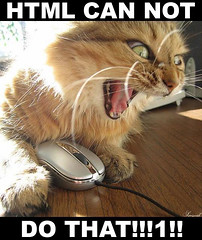Demo Tips
April 13th, 2010[ Guelph Tech ]
By the end of this week I’ll have organized and hosted 13 DemoCampGuelph events. Along the way I’ve seen some incredible demo’s. I’ve learned, I’ve been impressed but I’ve also been embarrassed and outright skeered. People often ask for tips and information related to demo’ing but to be honest I’m not the expert. While I have demo’d at other events such as DemoCampToronto, I’m only the mc. You wouldn’t ask Whoopi Goldberg how to win an Oscar would you? (Let’s pretend she only hosted the oscars and didn’t win two of them as well…)
 So, now that I’ve told you not to listen to me, here’s a few quick tips if you’re thinking of demo’ing:
So, now that I’ve told you not to listen to me, here’s a few quick tips if you’re thinking of demo’ing:
- DemoCamp’s are not pitch events. Don’t pitch or market to the crowd, no one’s here to be sold to.
- Don’t delude yourself. You’ve only got 5 minutes! You can’t demo the entire feature set of your CRM that’s going to save the world so don’t try. Pick an area within your product or a specific feature or workflow that will interest the crowd and demo that alone.
- Focus your message. Just because this is a demo event doesn’t mean you shouldn’t focus on a message we take away from your demo. What’s the sentence you’d like me as a listener to type into twitter when you’re done? Thinking this way helps focus your demo and hopefully have a consistent flow to it.
- Be prepared for technology to fail and keep presenting. If you get 5 minutes to pitch to a key investor, they aren’t going to wait 15 while you work out wifi issues. Have something prepared if the network or projector or mic etc fails. Improvise and keep moving.
- It’s cliche but take your time and have fun. This is a community event of peers who appreciate you putting the time in to show what your passionate about so chill and enjoy the experience. You can stress out on your wedding day.
Some great tips from DemoCampGuelph12’s Crowie award winner Tony Thompson:
- “First off, some kind of a presentation outline is good. I just use point form notes. Make sure you have some detail you can cut out, or insert on the fly depending on your audience interest.”
- “The eBar is a big room. The audience will not be able to see you as much as they can see your live demo — so your demo must work and look nice. When you want to make a point, you won’t be able to do it with your facial expression alone, you’ll have to do it verbally as well.”
- “Keep any graphics simple and to the point. To anybody more than halfway down the bar, the projection screen will look like a file card, and they won’t be able to make out any fine detail.”
Tony left out his secret sauce, more robots = good.
